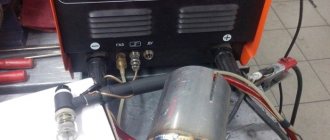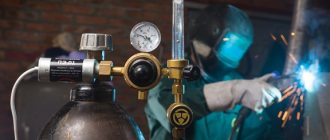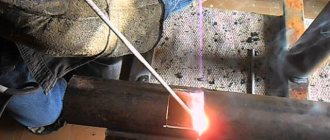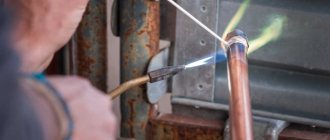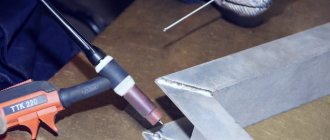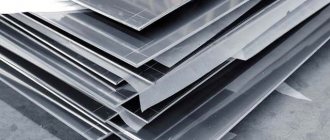Manufacturers produce household and industrial equipment for welding work. Automatic and semi-automatic are more often used in production, less often in auto repair shops. How are these devices different? What the difference is will become clear if you know the device of each. The differences between the equipment are significant. Welders are classified according to various criteria.
Features of semi-automatic welding machines
Semi-automatic welding is convenient when using welding wire. It is possible to use flux, carbon dioxide or inert gas, which protects the metal from oxidation and saturation of the melt with hydrogen.
The process of semi-automatic and automatic welding is the same:
- the electrode forms an arc;
- the filler wire fed into the working area is melted;
- a suture bead of the required thickness is formed.
Semi-automatic welding technology
The devices, depending on the design, are equipped with additional functions. The models differ:
- current sources and devices are connected to generators and inverters;
- types of gas (produced by carbon dioxide welders and those working with an inert environment);
- placement of the wire spool: inside the housing or outside.
The main advantages of semi-automatic welding:
- the ability to use standard mass-produced consumables;
- the welder can always intervene in the process;
- no changeover between different types of welded joints or workpieces is required;
- the wire is fed into the working area at the same speed;
- the device relieves the welder from the procedure of replacing consumable electrodes;
- versatility.
The devices are widely used in industry and everyday life.
Working with a semi-automatic machine requires experience and dexterity
Content
- Semi-automatic or inverter: which is better for a beginner
- How to choose a welding machine for a beginner: what to look for
- Our top best welding machines for beginners
You can weld a frame for a canopy, greenhouse or gate, install bars on the windows of a country house, and carry out minor repairs in the garage yourself.
To do this, you need to understand the welding process and select a welding machine. There are models on sale for household, semi-professional and professional purposes with different characteristics, functionality, capabilities and prices. We share tips on which welding machine to choose and buy for a beginner for a summer house or home, based on the upcoming tasks.
How does a welding machine work?
The benefits of the automated process are felt when repeating the same type of operations: conveyor assembly of components, production of welded parts. Automatic welding eliminates the human factor. After setting up the equipment, the operator only turns the machine on and off.
In a complex device, welding is fully automated. The device maintains a stable arc, the distance between the electrode and the workpiece is constant. The quality of the seams depends on the professionalism of the adjusters. The machine can be configured:
- for spot welding, for example, in the production of welded mesh;
- welding complex seams along a given contour;
- endless seam formation in the production of welded rolled products.
What is the difference between an automatic and a semi-automatic?
First, about the similarities. The devices can use shielding gas, flux, and use flux-cored wire. The difference between automatic machines and semi-automatic machines is the share of human participation.
When deciding what to choose: automatic or semi-automatic, take into account the capabilities of the equipment. The machines are produced in several types:
- single- and multi-electrode, with which several connections are made simultaneously;
- for suspended ones, only the position of the welding head is shifted, all other units are fixed permanently (used for curved seams);
- self-propelled ones are equipped with a trolley; during the welding process, not only the head, but also the mechanism itself moves (used in conveyor production);
- welding tractors are self-propelled, capable of moving along guides or the part itself, making continuous long seams, for example, in the manufacture of welding pipes.
Welding tractor
The devices are also classified according to the type of welding process:
- in the down position;
- welding vertical surfaces horizontally;
- connections with forced formation.
The operator sets up the equipment and checks how the equipment works. Does not participate in the formation of the seam, does not control the position of the torch or electrode.
It is clear that automatic machines are complex equipment, equipped with electronics and a control unit. The payback period for automatic mechanisms is long. A small workshop cannot afford to purchase such automatic welding equipment.
Semi-automatic machines pay for themselves quickly. Often purchased for field work of increased complexity. In a semi-automatic machine, only the additive supply process is mechanized. The wire is moved by guide rollers, the speed of which is controlled by the welder. Semi-automatic devices are classified:
- by the number of electrodes;
- purpose (there are types for steel, cast iron, non-ferrous metals);
- functionality: universal for all types of welding and without gas equipment.
Experienced welders use semi-automatic welders; it is necessary to maintain the distance between the machine and the metal, maintain the arc, and regulate the supply of shielding gas.
Briefly about the differences!
A semi-automatic welder with experience works and controls all parameters of the welding process - welding is done manually.
The machines are operated by an operator who makes the settings - welding occurs automatically according to the specified coordinates.
Video description
How to set up a semi-automatic machine.
Polarity when working with self-shielding wire
DC welding can be with direct polarity - a plus is connected to the product, and a minus goes to the electrode; welding with reverse polarity is connected in reverse Source lemzspb.ru
As already mentioned at the very beginning of the article, there is direct and reverse polarity, which is quite clearly shown in top image. When the polarity changes, the flow of electrons in the circuit changes. We will not talk about the theories of electron motion - from plus to minus or vice versa, because it is generally considered dualistic after the creation of Alessandro Volta's column, but we will dwell on the method of working with flux-cored wire.
So, straight polarity means that there is a plus on the electrode, and a minus on the product where the polar clamp is attached. In the case of reverse polarity, everything looks the other way around - there is a minus on the electrode, and a plus on the clamp. If we talk about welding with self-protected flux-cored wire, then direct polarity is used, while when welding with a protective gas shell, reverse polarity is used. This state of affairs allows you to extract maximum voltage for the semi-automatic device, therefore, the device will operate in the most optimal mode.
Note: situations are possible when self-protected flux-cored wire is used with reverse polarity, but this depends on its marking.
Are sound waves important when working with a semi-automatic machine?
The welder cannot be deaf, and this is clear, since when working MIG/MAG it is necessary to listen to the sound coming from the weld pool area, as well as observe the process through tinted glass (especially important for beginners). If the process proceeds correctly, the sound will be similar to when meat is fried in a hot frying pan - an even hiss without crackling or explosions. If the splashes freeze on the electrode or burner, the sound will immediately change - crackling and hissing will begin, as if water is being added to a frying pan. Also, the sound quality is significantly affected by the density of the clamping mass - if the crocodile does not grip the workpiece well, then the sound will be uneven in any case.
Safety when working with semi-automatic machines
The light that is generated during any type of electric arc welding is critically harmful to vision Source samsvar.ru
“Eyes!” - anyone who was present while a professional was working probably heard this expression, which any adequate welder will certainly voice before touching the metal surface with an electrode. Eye protection when working with arc welding of any type is the most important safety requirement. To burn the iris of the eye, three or four flashes are enough, after which a feeling of “sand” and one or two sleepless nights are ensured. For this purpose, welding helmets with tinted glass are used, and some manufacturers of semi-automatic machines offer them as a factory kit: that is, the mask comes as an addition to the machine.
An important role is played by gloves or mittens that protect your hands from molten splashes and heat from the holder. In addition, any arc welding is a powerful stream of ultraviolet radiation, and if unprotected areas of the skin are exposed to such baths for at least one minute, then a serious burn is guaranteed. For example: when a mechanic works with a welder (supports some workpieces during work), then by the end of the working day a tan will appear on his face, and sometimes he even has to make anti-burn masks (sour milk, sour cream, etc.).
When working with any welding, you definitely need a protective suit that cannot be burned through by splashes of molten metal. This is also important, since even one drop on the body is tantamount to a burn. If a special suit is not available, it is important that synthetics are completely excluded from clothing, as they will aggravate the situation. Shoes should be closed, but not rag (leather or leatherette) - it is best if they are not shoes, but boots. If work is carried out indoors, proper ventilation must be provided.
What is the point of using semi-automatic welding if there are automatic machines?
The functionality of automatic and semi-automatic welding machines differs. Automatic welding is necessary for critical complex connections and mass production. Can work continuously for a long time. Semi-automatic welding is necessary to obtain high-quality, uniform seams with a small amount of work. Setting up semi-automatic machines does not require months of preparation; maintenance of semi-automatic machines is inexpensive. There is no need to create special conditions for welding. Welders work indoors and outdoors; installation does not require a flat area with a coating of the established density. Another argument in favor of semi-automatic welding equipment is mobility. Automatic welding machines are used only:
- in the technological chain;
- on a line with unified control;
- to perform similar operations.
Types of automatic devices
Based on their design solutions, automatic welding equipment is divided into several types:
- Tractor type. For work under a layer of flux or in an environment of protective gases.
- Suspended welding machine. For use in protective gas environments.
- Multi-arc device. There are modifications of both tractor and suspended versions.
Tractor type
The first type of devices was developed and released in the USSR. Design requirements are regulated by GOST 8213-69. Widely used in heavy industry.
Welding tractor
As an example, consider the design of a single-engine tractor of the TS-17-R type. As the name suggests, the tractor has only one electric motor. It is designed to perform work under a layer of flux when welding various butt seams. In this case, the minimum radius of circumferential seams is 600 mm.
An electric motor drives the running mechanism and the wire feeder. All three elements have a common body, which is the supporting structure of the tractor. It serves as a support for other mechanisms: the flux loading hopper, the wire drum and the control unit.
The electrode is located near the vertical axis, which passes through the center of gravity. This feature allows you to work inside containers: the low center of gravity provides increased stability.
Overhead welding machine
Suspended type equipment consists of the following basic elements:
- Feeding device.
- Drive caliper.
- Vertical movement mechanism.
- Flux bunker.
- Wire drum.
- Control block.
Overhead welding machine
Suspended equipment is divided into stationary and self-propelled units.
Stationary devices are distinguished by the fact that before starting work they are installed in the selected location and are not moved until the work is completed. The main area of application is pipe connection. Self-propelled vehicles are equipped with a trolley for moving around the work site. They are distinguished by their ability to create permanent connections of considerable length.
